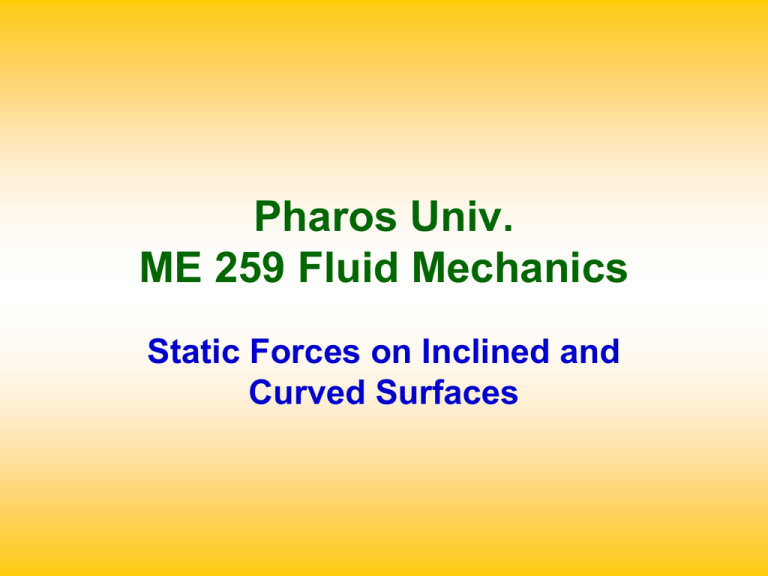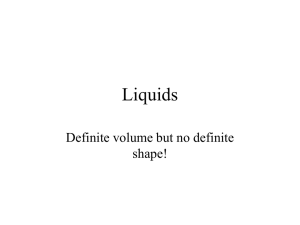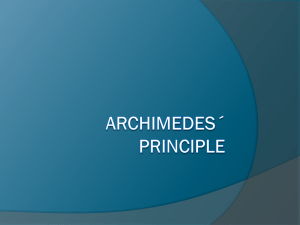P 1
advertisement

Pharos Univ. ME 259 Fluid Mechanics Static Forces on Inclined and Curved Surfaces Main Topics The Basic Equations of Fluid Statics Pressure Variation in a Static Fluid Hydrostatic Force on Submerged Surfaces Buoyancy The Basic Equations of Fluid Statics Body Force The Basic Equations of Fluid Statics Surface Force The Basic Equations of Fluid Statics Surface Force The Basic Equations of Fluid Statics Surface Force The Basic Equations of Fluid Statics Total Force The Basic Equations of Fluid Statics Newton’s Second Law The Basic Equations of Fluid Statics Pressure-Height Relation 2.3.1 Pressure and head Free surface P2 = Patm h ya P1 y In a liquid with a free surface the pressure at any depth h measured from the free surface can be found by applying equation (2.3) to the figure. From equation (2.3): P1 – P2= g (ya-y) But Thus, ya-y = h , and P2 = Patm (atmospheric pressure since it is at free surface). P1 – Patm= gh or P1 = Patm + gh (abs) or in terms of gauge pressure (Patm= 0),: P1 = gh = h (2.4) (2.5) Pressure Variation in a Static Fluid Incompressible Fluid: Manometers Pressure Variation in a Static Fluid Compressible Fluid: Ideal Gas Need additional information, e.g., T(z) for atmosphere Differential Manometer The liquids in manometer will rise or fall as the pressure at either end changes. P1 = PA + 1ga P2 = PB + 1g(b-h) + mangh P1 = P2 (same level) PA + 1ga = PB + 1g(b-h) + mangh or PA - PB = 1g(b-h) + mangh - 1ga PA- PB = 1g(b-a) + gh(man - 1) Figure 2.13: Differential manometer Hydrostatic Force on Submerged Surfaces Plane Submerged Surface Center of Pressure Line of action of resultant force FR=PCA lies underneath where the pressure is higher. Location of Center of Pressure is determined by the moment. I y p yC xx ,C yc A Ixx,C is tabulated for simple geometries. Hydrostatic Force on Submerged Surfaces Plane Submerged Surface We can find FR, and y´ and x´, by integrating, or … Hydrostatic Force on Submerged Surfaces Plane Submerged Surface • Algebraic Equations – Total Pressure Force Hydrostatic Force on Submerged Surfaces Plane Submerged Surface • Algebraic Equations – Net Pressure Force Table 2.1 Second Moments of Area Shape Rectangle b Area Ig bh bh3/12 bh/2 bh3/36 d2/4 d4/64 hh G G G G Triangle Gh hG h/3 h/3 GG b b Circle dd GG GG A 6-m deep tank contains 4 m of water and 2-m of oil as shown in the diagram below. Determine the pressure at point A and at the tank bottom. Draw the pressure diag. Pressure at oil water interface (PA) water = 1000 kg/m3 PA = Patm + Poil (due to 2 m of oil) = 0 + oilghoil = 0 + 0.98 x 1000 x 9.81 x 2 = 15696 Pa PA = 15.7 kPa (gauge) SG of oil = 0.98 Pressure at the bottom of the tank; PB = PA + waterghwater PB = 15.7x1000 + 1000 x 9.81 x 4 = 54940 Pa PB = 54.9 kPa (gauge) Pressure Diagram Patm = 0 2m oil PA=15.7 kPa A water PA 4m B PB = 54.9 kPA Hydrostatic Force on Submerged Surfaces Curved Submerged Surface Hydrostatic Force on Submerged Surfaces Curved Submerged Surface • Horizontal Force = Equivalent Vertical Plane Force • Vertical Force = Weight of Fluid Directly Above (+ Free Surface Pressure Force) Hydrostatic Forces on Curved Surfaces FR on a curved surface is more involved since it requires integration of the pressure forces that change direction along the surface. Easiest approach: determine horizontal and vertical components FH and FV separately. Forces on Curved Surfaces h1 h2 Submerged Curved Surface Resultant force:Horizontal and vertical components Horizontal component: • FH = *s*w*(h + s/2),Where, h = Depth to the top of rectangle (beginning of curve surface) s = projected rectangle height w = projected rectangle length or width • Center of pressure hp = hC + IC/(hCA) hC = h + s/2 Vertical Component FV = *Volume *A*w Where, FR FH2 FV2 FV tan FH A = entire area of fluid w = projected rectangle length or width 1 Hydrostatic Buoyant Force Archimedes’ principle When a body is submerged or floating, the resultant force by the fluid is called the buoyancy force. This buoyancy force is acting vertically upward The buoyancy force is equal to the weight of the fluid displaced by body. The buoyancy force acts at the centroid of the displaced volume of fluid. A floating body displaces a volume of fluid whose weight - body weight For equilibrium: + ΣFy = 0 Fb – W = 0 or Fb = W Therefore we can write ; W = mg W = mg Fb = weight of fluid displaced by the body Or Fb = W = mg = g Where Fb = buoyant force = displaced volume of fluid G B Volume of displaced fluid W = weight of fluid Fb= W G B Fb = W Buoyancy Buoyancy For example, for a hot air balloon Buoyancy and Stability Buoyancy is due to the fluid displaced by a body. FB=fgV. Archimedes principal : The buoyant force = Weight of the fluid displaced by the body, and it acts through the centroid of the displaced volume. Buoyancy and Stability Buoyancy force FB is equal only to the displaced volume fgVdisplaced. Three scenarios possible 1. body<fluid: Floating body 2. body=fluid: Neutrally buoyant 3. body>fluid: Sinking body Stability of Immersed Bodies Rotational stability of immersed bodies depends upon relative location of center of gravity G and center of buoyancy B. • G below B: stable • G above B: unstable • G coincides with B: neutrally stable. Stability of Floating Bodies If body is bottom heavy (G lower than B), it is always stable. Floating bodies can be stable when G is higher than B due to shift in location of center buoyancy and creation of restoring moment. Measure of stability is the metacentric height GM. If GM>1, ship is stable.





